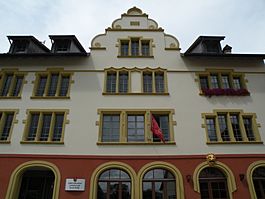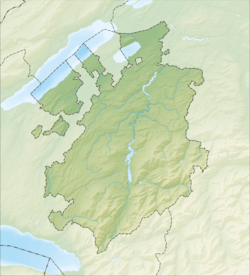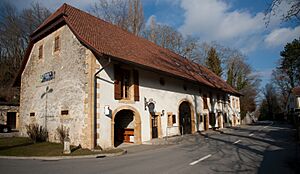Mont-Vully facts for kids
Quick facts for kids
Mont-Vully
|
||
|---|---|---|

Municipal administration building in Haut-Vully
|
||
|
||
| Country | Switzerland | |
| Canton | Fribourg | |
| District | See | |
| Area | ||
| • Total | 17.51 km2 (6.76 sq mi) | |
| Population
(Dec 2020 )
|
||
| • Total | 4,123 | |
| • Density | 235.47/km2 (609.85/sq mi) | |
| Postal code |
1787 Môtier
1789 Lugnorre 1786 Sugiez 1788 Praz |
|
| Surrounded by | Cudrefin (VD), Faoug (VD), Greng, Ins (BE), Meyriez, Mur (VD), Murten/Morat | |
Mont-Vully is a town, also called a municipality, located in Switzerland. It's in the See district, which is part of the Canton of Fribourg. This town was formed on January 1, 2016, when two older towns, Bas-Vully and Haut-Vully, joined together to become one.
Contents
A Look at Mont-Vully's Past
Mont-Vully has an interesting history, especially since it was formed by two older towns.
How Mont-Vully Was Formed
The area known as Haut-Vully was first mentioned in old writings around the years 968 to 85. Back then, it was called Vuisliacense. Later, in 1453, it was known as Vuilliez.
Bas-Vully also appeared in records around 968, called Williacense. For a long time, until 1831, it was known by a longer name: vor Commune générale des quatre villages de La Rivière. It also had a German name, Unterwistenlach, but that name is not used anymore. These two towns eventually merged to create the Mont-Vully we know today.
Mont-Vully's Location and Size
Mont-Vully covers an area of about 7.47 square kilometers. This makes it a medium-sized municipality in Switzerland.
Who Lives in Mont-Vully?
Mont-Vully is home to many people. As of 2014, its population was 1. (Note: This number seems to be a placeholder from the original data and might not be the current population.)
Important Historical Places in Mont-Vully
Mont-Vully is home to several places that are considered very important to Swiss history and culture. These are called heritage sites of national significance.
Famous Houses and Ancient Forts
Several old houses in Mont-Vully are protected because of their historical value. These include:
- The House De W. J. Merz
- The Gatschet House
- The Les Rondas House
- The De Steiger House
- The d’Erlach-Velga House
- The de Wattenwyl House
Also, the oppidum of Mont Vully is a very important site. An oppidum was a large, fortified settlement used by ancient people, often before the Roman Empire. It's like an old fort or town.
The entire villages of Môtier and Praz are also special. They are part of the Inventory of Swiss Heritage Sites, which means their whole look and feel are protected because they show important Swiss heritage.
Mont-Vully's World Heritage Site
Mont-Vully is special because it's home to a UNESCO World Heritage Site. This means it's a place recognized by the United Nations as having outstanding universal value.
The Ancient Pile-Dwelling Settlement
The site in Mont-Vully is called Môtier I. It's a prehistoric pile-dwelling settlement. Imagine houses built on stilts over water or wet ground! These sites are part of the Prehistoric Pile dwellings around the Alps World Heritage Site.
The Môtier I site hasn't been studied a lot, but it seems to be a settlement from the Neolithic period, also known as the New Stone Age. This is based on stone axes found there. The site was discovered in 1860. In 2003, a small team found a thick layer of old artifacts. This ancient village is now buried under earth and is on dry land, but it was once likely near water. It stretches for about 190 meters long and 50 to 70 meters wide.
Getting Around Mont-Vully
Mont-Vully has its own railway station called Sugiez. This station is on the Fribourg–Ins railway line. From here, you can easily travel by train to nearby towns like Fribourg, Ins, and Neuchâtel.











